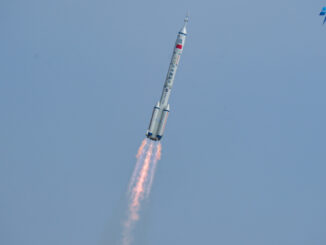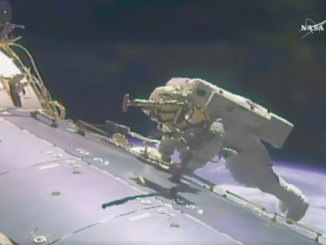EDITOR’S NOTE: Updated Oct. 4 to correct reference to SuperDraco abort engines.

Images taken inside SpaceX facilities at Cape Canaveral and released by NASA Thursday show the Crew Dragon capsule and Falcon 9 booster assigned to an in-flight abort test of the new human-rated spaceship later this year, a prerequisite before astronauts climb aboard for a mission to the International Space Station.
NASA and SpaceX officials have not disclosed a target date, or timeframe, for the critical in-flight abort test in months. But the test flight is expected later this year, and the Crew Dragon’s first orbital flight with astronauts is likely to occur in early 2020, according to NASA and industry officials.
The in-flight abort test will verify the Crew Dragon’s SuperDraco thrusters are capable of pushing the spacecraft away from a Falcon 9 rocket after liftoff. The safety system would allow astronauts to escape a catastrophic launch failure.
NASA has not updated the schedule for the remaining test flights by its commercial crew partners — Boeing and SpaceX — since early April. In July, NASA said target launch dates for the remaining commercial crew test flights were under review.
NASA Administrator Jim Bridenstine, in an interview with CNN Monday, said the Starliner’s first space mission is “months” away. SpaceX founder Elon Musk told CNN Saturday that the Crew Dragon spacecraft, which conducted its unpiloted test flight to the station in March, would be ready to carry astronauts in three or four months.
But a pad abort test by Boeing and an in-flight escape test by SpaceX are required before NASA clears either spacecraft to carry astronauts. NASA gave both companies the option of conducting an in-flight abort demonstration, and Boeing elected to forego such a test.
A regulatory filing with the Federal Communications Commission last month suggested the in-flight abort test was scheduled for no earlier than November.
The photos tweeted by NASA Thursday show the Crew Dragon spacecraft for the in-flight abort test inside a processing facility at Cape Canaveral, and a previously-flown Falcon 9 booster inside a SpaceX hangar at the Florida spaceport.
The Crew Dragon spacecraft set to fly on the in-flight abort test was originally built to carry NASA astronauts Bob Behnken and Doug Hurley to the space station on SpaceX’s first crewed mission, designated Demo-2.
Behnken and Hurley are training for the Demo-2 mission, which will be a final orbital test flight before NASA approves the Crew Dragon for regular space station crew rotation flights, initially with four astronauts per mission.
SpaceX originally planned to reuse the Crew Dragon spacecraft from the Demo-1 mission, an unpiloted test flight to the space station in March, for the in-flight abort test. But the capsule was destroyed April 20 in an explosion before a hotfire test of the ship’s SuperDraco abort engines.
Investigators traced the most likely cause of the explosion to a faulty valve inside the Crew Dragon propulsion system, and SpaceX repurposed the next spacecraft on the Crew Dragon assembly line for the in-flight abort test.
After the assembly line shuffle at SpaceX headquarters in Hawthorne, California, the third space-rated Crew Dragon spacecraft is now slated to ferry Behnken and Hurley to the station, likely in early 2020, before future SpaceX capsules begin operational crew rotation missions.
The photo released by NASA show the Crew Dragon for the in-flight abort test surrounded by scaffolding. Before it can be installed on top of its Falcon 9 launcher, ground teams will attach the capsule to a trunk section, or service module.

Eight SuperDraco rocket engines mounted in pods around the circumference of the Crew Dragon are programmed to quickly fire if computers detect an emergency during launch. NASA and SpaceX want to ensure the escape system is up to the job before putting astronauts on the spacecraft.
SpaceX conducted a pad abort test in 2015 to demonstrate the capsule’s ability to escape a rocket explosion on the launch pad. The in-flight abort will verify the abort function during a real rocket launch.
Before the Crew Dragon explosion on a test stand in April, SpaceX and NASA aimed to conduct the in-flight abort test some time in July, followed by the crewed Demo-2 mission in September. But other issues would have likely challenged that schedule, including a parachute test failure in April and slow progress with certification and safety reviews.
The in-flight abort test plan calls for the rocket to take off from launch pad 39A at the Kennedy Space Center and arc over the Atlantic Ocean, firing its nine main engines more than a minute, as it would during a typical launch. SpaceX will pre-program the Falcon 9’s nine Merlin booster engines to switch off after surpassing the speed of sound, according to an environmental assessment for the test flight released by the Federal Aviation Administration.
A computer on the Crew Dragon spacecraft will detect the loss of thrust and trigger an abort between 83 and 100 seconds after liftoff. The SuperDraco escape engines will ignite almost instantaneously to push the craft away from the Falcon 9 launcher at an altitude between 48,000 feet and 91,000 feet (14.6 to 27.8 kilometers), officials wrote in the FAA environmental assessment.
The Falcon 9 assigned to the in-flight abort test will fly with a complete first stage and second stage, except for a second stage Merlin engine, which is not required for the test.
According to the environmental assessment, SpaceX does not plan to recover the Falcon 9 booster after the escape command. Officials will monitor the break-up of the Falcon 9 first and second stages, while the Crew Dragon will deploy parachutes to splash down in the Atlantic Ocean off the Florida coast, where teams will recover the capsule.
Email the author.
Follow Stephen Clark on Twitter: @StephenClark1.



